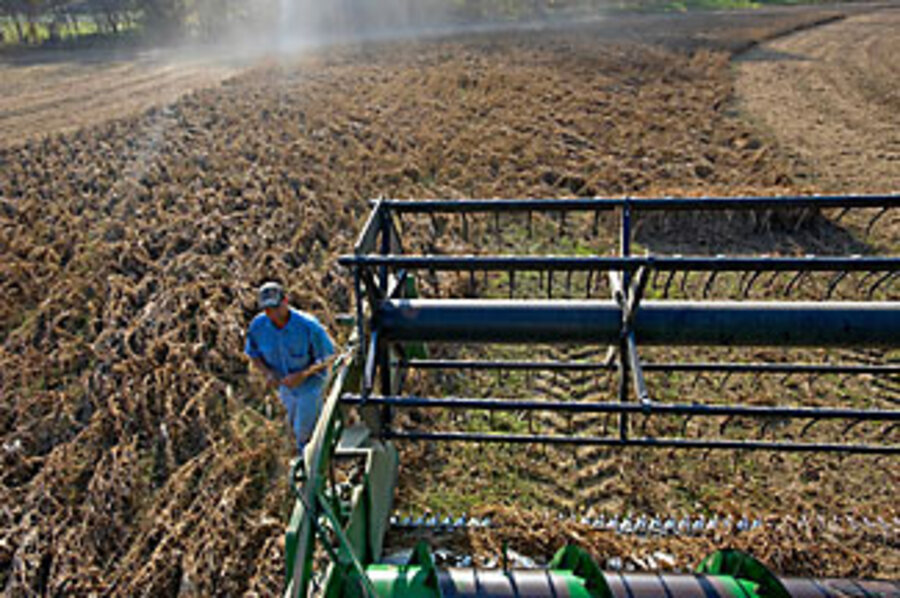A lone bright spot in real estate: farmland
Loading...
| Solon, Iowa
While urban and suburban homes are falling in value, farmland is soaring. It's arguably America's strongest real estate market.
Nationally, farmland is up nearly 9 percent from a year ago. In Iowa, it's up 18 percent; South Dakota, up 21 percent. Illinois has seen farmland values nearly double since 2004.
But rising land values cut both ways for farming communities. While they increase local wealth of landowners and bring in new money, they also shut most young people out of farming and cause even established producers to pay more to rent land. They also speed the concentration of farmland into fewer and fewer hands, some economists and rural advocates say.
Rising values put land "out of reach to all but those who have large farms and/or corporate backing," says Brian Dabson, a professor at the Truman School of Public Affairs at the University of Missouri-Columbia and executive vice president of the Rural Policy Research Institute. "And that's not healthy for a rural economy."
Land prices certainly hurt the young and the aspiring farmers.
Jarrett Smith, of Spencer, Iowa, raises a small crop of corn and soybeans while working as a salesman for a seed company. Like many young people in his position, he would like to devote himself wholly to farming. But he sees little chance of that soon. "Right now, I could only dream of getting some ground."
The same sentiment echoes across rural America, especially here in the Midwest.
"There are a whole lot of young people wanting to farm – both children of farm families and young people from cities and suburban towns who want to farm," says Teresa Opheim, executive director of Practical Farmers of Iowa, a farm group whose members range from corn-and-soybean farmers to small vegetable growers. "The price of land is making it very, very difficult for them to get started, even to come up with a business plan that's viable."
Rented land even harder to get
Renting land, a traditional way into full-time farming, is even harder than buying. Young farmers say the competition is so fierce that rental land is quickly gobbled up by established farmers who can afford to farm on narrower margins and pay higher rents.
The rising cost of farmland is a problem not just for young farmers. Many corn-and-soybean farmers rent two or three times as much cropland as they own. As land values rise, so do their rental costs.
Farmers are paying dramatically more for almost everything, not just land but also fuel, fertilizer, and seed. Those who grow major commodities like corn, soybeans, and wheat need to spend more and more to put in a crop, squeezing margins and boosting risk if crop prices nosedive or if a flood or other natural disaster hits.
The rise in land values reflects the extraordinary profits from agriculture lately. US energy policy, which encourages the production of ethanol from corn, has helped to drive up both crop prices and farm incomes. The US Department of Agriculture (USDA) estimates that farmers will earn a record $95.7 billion this year, 10.3 percent more than last year and 57 percent more than the 10-year average of $61.1 billion.
Farmers have been plowing much of this profit back into their farms, buying equipment and land. In recent years, investors had overtaken farmers as the largest buyers of farmland. Now most buyers are again farmers.
"Everybody wants to buy more ground," says Clint Veren, a loan officer who also farms near Marshalltown, Iowa. "The only way to be more profitable is to get additional land."
With prices so high, bidders stay away
Acquiring land has never been easy or cheap. Still, high prices scare off many potential buyers long before the bidding starts.
"Even middle-aged farmers don't have the capital to buy land," says Ryan Ross, who works for a farm-supply company and farms in his spare time. This year Mr. Ross, who has been farming for 12 years, considered buying 45 acres a few miles from his farm. In the end, he couldn't bring himself to attend the auction. "I did some crunching and, knowing the price it would be, I did not want to take the risk," he said. The field ended up selling for $5,600 an acre, a relatively modest price compared with the $8,000 or $9,000 an acre that the best farmland fetches.
The global financial crisis and fears of recession may have slowed the increase in land values, says Jason Henderson, an economist with the Federal Reserve Bank in Kansas City. Corn prices have fallen, following closely on the drop in oil prices. But the USDA expects prices to rebound.
Despite the apocalyptic headlines of recent weeks, many economists and land agents don't expect land prices to fall far, if at all. "It's viewed as a very safe investment," says Troy Louwagie, a land consultant in Mount Vernon, Iowa.
In the meantime, young farmers haven't stopped trying to acquire land. Earlier this year, Christopher Bone, a junior at Iowa State University in Ames and president of the university's Beginning Farmers Network, hoped to buy 160 acres for sale next to his family's land. Planning to finance part of the purchase with earnings from his job at a local farmers co-op, he met with a banker, studied yield records, and calculated his costs. "I looked and looked at it," he said. Then he said no.
"It would have worked out great, being able to work and farm at the same time," he said. But "if we had a drought, I'd be in big trouble."





